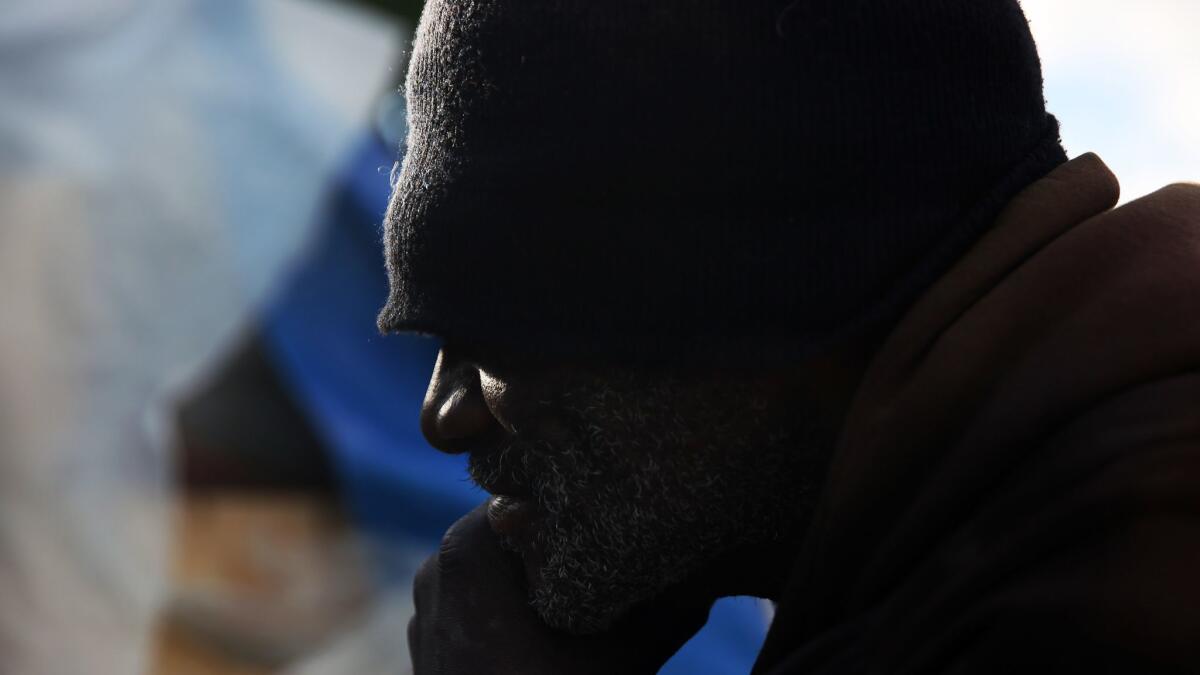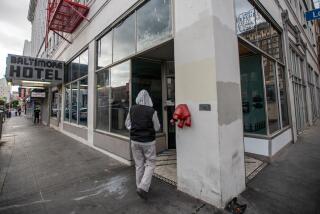L.A. agrees to let homeless people keep skid row property — and some in downtown aren’t happy

In a pivotal legal settlement, the city of Los Angeles has agreed that it won’t put a ceiling on the total amount of property that homeless people can keep on skid row, but will throw away sofas, refrigerators and other large items crowding the squalid 50-block area of downtown.
The agreement, released Wednesday and reached after months of closed-door negotiations, applies only to skid row and adjoining streets.
It covers an area bounded by 2nd Street on the north, 8th Street on the south, Spring Street on the west and Alameda Street on the east. Spring and 2nd streets are heavily traveled commercial streets, with a high concentration of shops, restaurants and pedestrian activity.
Under the settlement terms, the city will have the authority to seize and destroy contraband, hazardous materials or rat-infested property that threatens public health and safety, as well as so-called “bulky items” — pallets, refrigerators, couches or other types of furniture.
But other possessions seized during arrests or encampment cleanups must be segregated, clearly marked and stored for 90 days in a skid row warehouse. Medication and other critical items must be available to be returned within 24 hours.
The city also agreed to give better notice of upcoming cleanups and to pay plaintiffs $645,000 in attorney fees, legal costs and damages. The settlement will be in effect for three years.
The case, Carl Mitchell et al. vs. city of Los Angeles, marks a critical flex point in L.A.’s long struggle to balance homeless people’s property rights against the welfare and qualify of life of the whole community.
Because the lawsuit, filed in 2016, only targeted a specific geographic area of downtown L.A., the settlement sets a different standard than in the rest of the city, where authorities have set a limit on how much property that homeless people can store in the streets to what can fit in a 60-gallon container.
Some civil rights attorneys believe the 60-gallon limit is unconstitutional and the settlement states that the parties do not waive future challenges over enforcement under any law, state or federal.
The lawsuit, known as the Mitchell case, accused the city of using street cleanups and minor arrests as a pretext to seize and destroy homeless people’s property on skid row, where more than 2,000 people sleep in tents and lean-tos in the largest concentration of encampments in the country.
How the agreement will affect skid row’s sprawling camps is unclear. The city has limited storage capacity for homeless people’s goods, and it spent $31 million last year on camp cleanups citywide without making an appreciable difference in skid row’s sordid conditions. Sanitation officials had said at a public hearing that the sofas, refrigerators and other big items were their biggest worry.
Homeless advocates said the settlement would force a more humane response to the rolling crisis on skid row.
“It’s good to know people’s right to property is going to be protected,” said General Dogon of the Los Angeles Community Action Network, a skid row anti-poverty group and a plaintiff in the case.
Advocate and civil rights attorney Carol Sobel called the settlement an “important first step” but added, that “what we want most of all is for the city to come up with a plan that addresses the needs of everyone, including those experiencing homelessness.”
A spokesman for City Attorney Mike Feuer, who negotiated the settlement with lawyers for homeless individuals and advocacy groups, said that it “provides the city the authority and flexibility it needs to address health and safety issues related to homelessness.”
But Jessica Lall, chief executive of the Central City Assn., a downtown-based business group that fiercely fought the agreement, said it keeps in place rules that have made it difficult for the city to clean up skid row and address homelessness.
“Because there are no limits on the amount of things that can exist on the sidewalk, it is hard to determine what is someone’s belongings and what is trash,” said Lall, adding that her group’s board of directors will consider a possible legal challenge. “It’s hard for sanitation workers to determine if something is a public health concern if it’s buried in a pile of stuff.”
Nick Previsich, who lives in a Spring Street condominium, said the settlement will simply expand the boundaries of skid row.
“We have rats. I’ve seen them coming in and out of the tents,” he said. “What’s going to happen is a proliferation of really, really serious health problems.”
Alex Comisar, a spokesman for Mayor Eric Garcetti, called the agreement “the outcome of several unfortunate options” but added: “It’s time we break the cycle of litigation that keeps us from helping people in need.”
For decades, the city has been entangled in litigation over camp sweeps and property seizures on skid row. In April 2016, U.S. District Judge S. James Otero ordered the city to stop taking and destroying homeless people’s possessions on skid row unless they threatened health and safety, and later turned down the city’s request to set volume property limits.
In a series of closed-door sessions, Feuer recommended that the L.A. City Council settle the case. Downtown business owners and residents packed the council chambers, demanding that the city take the case to trial.
They argued skid row’s squalid camps hurt homeless people as much as those forced to work, live or pass by the trash-filled district. A group of recovering addicts said billowing tents helped homeless people hide and perpetuate their struggles with alcohol and drug abuse.
In the meantime, a federal court governing the western states, including California, ruled last year that cities can’t enforce anti-camping laws when shelter capacity is lacking, as it is in Los Angeles. An appeal of the ruling was denied last month.
Homeless advocates said the city was wasting money for enforcement and property seizures that should go toward housing or bathrooms, showers and washing stations to improve conditions in the street.
In March, the City Council in a closed session approved the framework for an agreement, but refused to make public the terms, prompting more protests.
“What the city may not do is to rewrite its laws behind closed doors under the guise of reaching a ‘settlement,’ ” a lawyer for the downtown Central City Assn. wrote the city attorney in April.
Last week, the council approved the attorney fees on a 12-2 vote and sent the settlement to Garcetti, who signed it Friday.
Councilmen Jose Huizar and Joe Buscaino, who opposed the settlement, said it would exacerbate skid row’s degradation.
The settlement “establishes a different set of standards that will only perpetuate the public health crisis that already exists in skid row,” said Buscaino, who represents the harbor area.
Huizar, whose downtown district includes skid row, said: “The city continues to set policy as a reaction to individual and ongoing lawsuits rather than agreeing to a comprehensive settlement … that will move us forward in a proactive path in helping us address our homelessness crisis.”
One of the four homeless people who filed suit, Michael Escobedo, 60, died of cancer in October. Two of the plaintiffs are now housed “and happy to have their own places,” Sobel said, but the lead plaintiff, Carl Mitchell, still lives on skid row.
Seated on a sagging plastic crate in front of the Hippie Kitchen soup line last week, Mitchell repeated the allegations that he made in the lawsuit: The LAPD arrested him for illegal possession of a supermarket shopping cart and took two carts full of his belongings, including medication for his high blood pressure and mental health condition.
He said he was released from LAPD lockup in the early hours of the morning with nothing but a blanket he found in an abandoned cart.
Mitchell said the lawsuit “had stopped the harassment on skid row.” But neither the cleanups, the litigation nor the millions of dollars spent on skid row programs have gotten him off the streets.
“It takes years to get a place,” he said.
Mitchell sleeps on a half-inch thick foam mat sandwiched between two billowing tents. “It’s hard to find a place to squeeze in between the tents,” he said. He said he is grateful for the street cleanups and cooperates when he can by moving his things out of the way of the power-washers and Hazmat teams.
“But why do they have to take the people out with the trash?” he asked. “Wherever you lay your hat is your home.”
»
More to Read
Start your day right
Sign up for Essential California for news, features and recommendations from the L.A. Times and beyond in your inbox six days a week.
You may occasionally receive promotional content from the Los Angeles Times.








